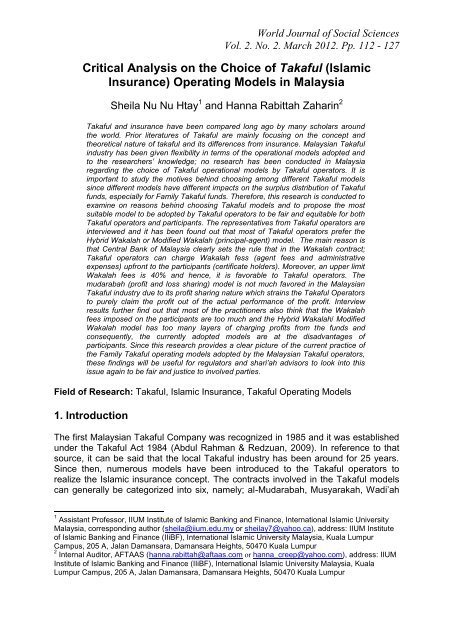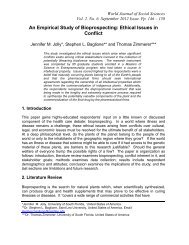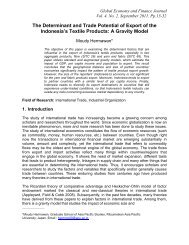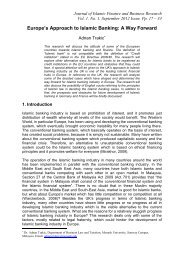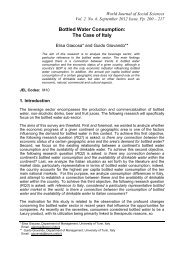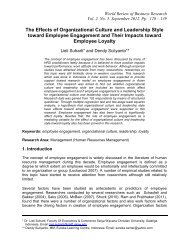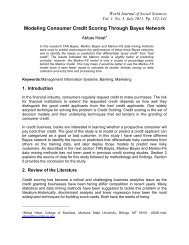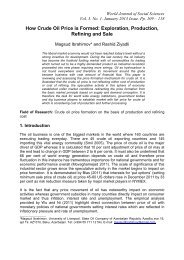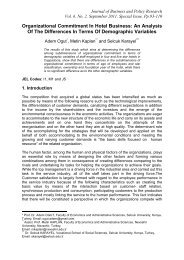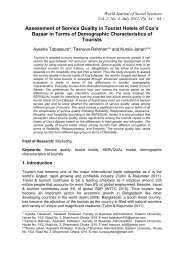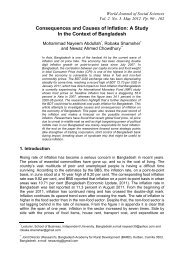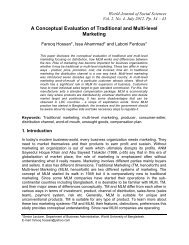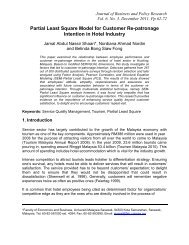(Islamic Insurance) Operating Models in Malaysia - Wbiaus.org
(Islamic Insurance) Operating Models in Malaysia - Wbiaus.org
(Islamic Insurance) Operating Models in Malaysia - Wbiaus.org
Create successful ePaper yourself
Turn your PDF publications into a flip-book with our unique Google optimized e-Paper software.
World Journal of Social Sciences<br />
Vol. 2. No. 2. March 2012. Pp. 112 - 127<br />
Critical Analysis on the Choice of Takaful (<strong>Islamic</strong><br />
<strong>Insurance</strong>) <strong>Operat<strong>in</strong>g</strong> <strong>Models</strong> <strong>in</strong> <strong>Malaysia</strong><br />
Sheila Nu Nu Htay 1 and Hanna Rabittah Zahar<strong>in</strong> 2<br />
Takaful and <strong>in</strong>surance have been compared long ago by many scholars around<br />
the world. Prior literatures of Takaful are ma<strong>in</strong>ly focus<strong>in</strong>g on the concept and<br />
theoretical nature of takaful and its differences from <strong>in</strong>surance. <strong>Malaysia</strong>n Takaful<br />
<strong>in</strong>dustry has been given flexibility <strong>in</strong> terms of the operational models adopted and<br />
to the researchers’ knowledge; no research has been conducted <strong>in</strong> <strong>Malaysia</strong><br />
regard<strong>in</strong>g the choice of Takaful operational models by Takaful operators. It is<br />
important to study the motives beh<strong>in</strong>d choos<strong>in</strong>g among different Takaful models<br />
s<strong>in</strong>ce different models have different impacts on the surplus distribution of Takaful<br />
funds, especially for Family Takaful funds. Therefore, this research is conducted to<br />
exam<strong>in</strong>e on reasons beh<strong>in</strong>d choos<strong>in</strong>g Takaful models and to propose the most<br />
suitable model to be adopted by Takaful operators to be fair and equitable for both<br />
Takaful operators and participants. The representatives from Takaful operators are<br />
<strong>in</strong>terviewed and it has been found out that most of Takaful operators prefer the<br />
Hybrid Wakalah or Modified Wakalah (pr<strong>in</strong>cipal-agent) model. The ma<strong>in</strong> reason is<br />
that Central Bank of <strong>Malaysia</strong> clearly sets the rule that <strong>in</strong> the Wakalah contract;<br />
Takaful operators can charge Wakalah fess (agent fees and adm<strong>in</strong>istrative<br />
expenses) upfront to the participants (certificate holders). Moreover, an upper limit<br />
Wakalah fees is 40% and hence, it is favorable to Takaful operators. The<br />
mudarabah (profit and loss shar<strong>in</strong>g) model is not much favored <strong>in</strong> the <strong>Malaysia</strong>n<br />
Takaful <strong>in</strong>dustry due to its profit shar<strong>in</strong>g nature which stra<strong>in</strong>s the Takaful Operators<br />
to purely claim the profit out of the actual performance of the profit. Interview<br />
results further f<strong>in</strong>d out that most of the practitioners also th<strong>in</strong>k that the Wakalah<br />
fees imposed on the participants are too much and the Hybrid Wakalah/ Modified<br />
Wakalah model has too many layers of charg<strong>in</strong>g profits from the funds and<br />
consequently, the currently adopted models are at the disadvantages of<br />
participants. S<strong>in</strong>ce this research provides a clear picture of the current practice of<br />
the Family Takaful operat<strong>in</strong>g models adopted by the <strong>Malaysia</strong>n Takaful operators,<br />
these f<strong>in</strong>d<strong>in</strong>gs will be useful for regulators and shari’ah advisors to look <strong>in</strong>to this<br />
issue aga<strong>in</strong> to be fair and justice to <strong>in</strong>volved parties.<br />
Field of Research: Takaful, <strong>Islamic</strong> <strong>Insurance</strong>, Takaful <strong>Operat<strong>in</strong>g</strong> <strong>Models</strong><br />
1. Introduction<br />
The first <strong>Malaysia</strong>n Takaful Company was recognized <strong>in</strong> 1985 and it was established<br />
under the Takaful Act 1984 (Abdul Rahman & Redzuan, 2009). In reference to that<br />
source, it can be said that the local Takaful <strong>in</strong>dustry has been around for 25 years.<br />
S<strong>in</strong>ce then, numerous models have been <strong>in</strong>troduced to the Takaful operators to<br />
realize the <strong>Islamic</strong> <strong>in</strong>surance concept. The contracts <strong>in</strong>volved <strong>in</strong> the Takaful models<br />
can generally be categorized <strong>in</strong>to six, namely; al-Mudarabah, Musyarakah, Wadi’ah<br />
1 Assistant Professor, IIUM Institute of <strong>Islamic</strong> Bank<strong>in</strong>g and F<strong>in</strong>ance, International <strong>Islamic</strong> University<br />
<strong>Malaysia</strong>, correspond<strong>in</strong>g author (sheila@iium.edu.my or sheilay7@yahoo.ca), address: IIUM Institute<br />
of <strong>Islamic</strong> Bank<strong>in</strong>g and F<strong>in</strong>ance (IIiBF), International <strong>Islamic</strong> University <strong>Malaysia</strong>, Kuala Lumpur<br />
Campus, 205 A, Jalan Damansara, Damansara Heights, 50470 Kuala Lumpur<br />
2 Internal Auditor, AFTAAS (hanna.rabittah@aftaas.com or hanna_creep@yahoo.com), address: IIUM<br />
Institute of <strong>Islamic</strong> Bank<strong>in</strong>g and F<strong>in</strong>ance (IIiBF), International <strong>Islamic</strong> University <strong>Malaysia</strong>, Kuala<br />
Lumpur Campus, 205 A, Jalan Damansara, Damansara Heights, 50470 Kuala Lumpur
Htay & Zahar<strong>in</strong><br />
Yad Dhamanah, al- Wakalah, Waqf and Ju’alah (Frenz and Soualhi, 2010; Frenz,<br />
2009). However, only al- Wakalah and al-Mudarabah are the only two models that<br />
have been implemented so far <strong>in</strong> <strong>Malaysia</strong> (Frenz and Soualhi, 2010; Frenz, 2009;<br />
Ali, Odierno & Ismail, 2008). All these contracts can be applied <strong>in</strong> both the General<br />
Takaful and Family Takaful (Bank Negara <strong>Malaysia</strong>, 2010; Ali, Odierno & Ismail,<br />
2008). However, the study aims only to lay a hand on the operational models of<br />
Family Takaful product. It can be observed that the general guidel<strong>in</strong>es of the Shari’ah<br />
pr<strong>in</strong>ciples give a lot of space to the Takaful operators to exercise variety operat<strong>in</strong>g<br />
models depend<strong>in</strong>g on which suit the bus<strong>in</strong>ess objectives most. The operat<strong>in</strong>g models<br />
for distribut<strong>in</strong>g the surplus are adequate as long as the Takaful operators fulfill certa<strong>in</strong><br />
fundamental components that do not contradict the govern<strong>in</strong>g Shari’ah pr<strong>in</strong>ciples.<br />
There exists <strong>in</strong>congruity about the practice of Family Takaful surplus distribution <strong>in</strong><br />
the <strong>Malaysia</strong>n Takaful companies. This research aims to <strong>in</strong>spect the current practice<br />
of Family Takaful operation models adopted by the Takaful companies <strong>in</strong> <strong>Malaysia</strong><br />
and to <strong>in</strong>vestigate whether there is any issue regard<strong>in</strong>g the methods selected by the<br />
Takaful operators <strong>in</strong> distribut<strong>in</strong>g the surplus specifically for the Family Takaful fund.<br />
Therefore, the ma<strong>in</strong> objective of this study is to propose the most suitable operational<br />
model for the <strong>Malaysia</strong>n Takaful companies to manage its Family Takaful fund. The<br />
secondary objectives are to exam<strong>in</strong>e the motives of the <strong>Malaysia</strong>n Takaful<br />
companies <strong>in</strong> choos<strong>in</strong>g a particular model for its Family Takaful fund, to know the<br />
impact of each model adopted by the <strong>Malaysia</strong>n Takaful companies <strong>in</strong> manag<strong>in</strong>g its<br />
Family Takaful fund and to analyze whether there is a need for a standardization of<br />
the operational models for the <strong>Malaysia</strong>n Takaful companies to manage its Family<br />
Takaful fund. These objectives have led to the follow<strong>in</strong>g ma<strong>in</strong> and sub-research<br />
questions:<br />
a. What is the most suitable operation model for the <strong>Malaysia</strong>n Takaful<br />
companies to manage its Family Takaful fund?<br />
b. What are the justifications of the <strong>Malaysia</strong>n Takaful companies to choose that<br />
particular model for its Family Takaful fund?<br />
c. How these Family Takaful operation models are affect<strong>in</strong>g the surplus<br />
distribution between participants and Takaful companies?<br />
d. Should there be a uniformity of the operation models for the <strong>Malaysia</strong>n Takaful<br />
companies to manage its Family Takaful fund?<br />
There are five sections all together for this paper. Section 2.0 discusses about the<br />
theoretical concept of surplus distribution models. Section 3.0 presents the research<br />
methods and design for this study. In particular, the researcher will expla<strong>in</strong> about the<br />
research approach, selection of data collection methods, design of research<br />
<strong>in</strong>struments, and sampl<strong>in</strong>g strategies. Section 4 is about the exist<strong>in</strong>g Family Takaful<br />
surplus distribution models <strong>in</strong> <strong>Malaysia</strong>. This section also discusses about the<br />
problems regard<strong>in</strong>g the adopted models. Section 5 summarizes the f<strong>in</strong>d<strong>in</strong>gs, makes<br />
recommendations and concludes the study.<br />
2. The Concept and Operational Mechanism of Family Takaful <strong>in</strong><br />
<strong>Malaysia</strong><br />
The modern day Takaful is claimed to have its first appearance <strong>in</strong> Sudan <strong>in</strong> 1979 and<br />
is mak<strong>in</strong>g its way throughout the world s<strong>in</strong>ce then (Farooq, Chaudhry, Alam &<br />
Ahmad, 2010; Wahab, Lewis and Hassan, 2007; Taylor, 2005; <strong>Islamic</strong> Fiqh<br />
113
Htay & Zahar<strong>in</strong><br />
Academy, 2000; and Maysami & Kwon, 1999). The ma<strong>in</strong> reason that Takaful is<br />
re<strong>in</strong>troduced <strong>in</strong> 1979 is because Muslim scholars have realized that the conventional<br />
<strong>in</strong>surance does not fulfill the Muslim ethics (Farooq, Chaudhry, Alam & Ahmad, 2010;<br />
Wahab, Lewis and Hassan, 2007; Taylor, 2006; <strong>Islamic</strong> Fiqh Academy, 2000; and<br />
Maysami & Kwon, 1999). They conceded that conventional <strong>in</strong>surance are deemed<br />
fasid because the contracts are engaged with gharar, maysir and the <strong>in</strong>vestment of<br />
premiums are riba-based. However, Qaradawi (1985) believes that the modern form<br />
and concept of <strong>in</strong>surance is acceptable and only opposes the means and methods of<br />
the conventional <strong>in</strong>surance. Lian (2006) summarizes that Takaful has been<br />
revolutioniz<strong>in</strong>g because the <strong>in</strong>dustry has been receiv<strong>in</strong>g support and approval from<br />
the Shari’ah scholars around the world. Basically, the world is experienc<strong>in</strong>g a<br />
vigorous Takaful <strong>in</strong>dustry and <strong>Malaysia</strong> is not an exception to this situation.<br />
The development of Takaful <strong>in</strong>dustry <strong>in</strong> <strong>Malaysia</strong> started when the Takaful Act 1984<br />
came <strong>in</strong>to force for the regulation of the Takaful bus<strong>in</strong>ess <strong>in</strong> the country. S<strong>in</strong>ce then,<br />
the Takaful market <strong>in</strong> <strong>Malaysia</strong> has grown from only one Takaful operator <strong>in</strong> 1985 to<br />
twelve Takaful operators <strong>in</strong> 2010 (Bank Negara <strong>Malaysia</strong>, n.d.). It is expected to<br />
expand further <strong>in</strong> an environment of stronger economic growth and more favorable<br />
<strong>Islamic</strong> bus<strong>in</strong>ess environment (Taylor, 2005 until 2009. This obviously shows that<br />
<strong>Malaysia</strong>’s Family Takaful bus<strong>in</strong>ess records an). The Takaful Key Indicators depicts<br />
that the total Takaful fund assets <strong>in</strong> the country have an <strong>in</strong>creas<strong>in</strong>g pattern each year<br />
(Bank Negara <strong>Malaysia</strong>, n.d.). The same report also confirmed that the total Family<br />
Takaful fund assets <strong>in</strong> <strong>Malaysia</strong> experience the same growth pattern and account for<br />
more than 50% of the total Takaful fund Assets (Bank Negara <strong>Malaysia</strong>, n.d.).<br />
Similarly, the General Takaful depicts an improvement <strong>in</strong> its total fund assets from<br />
2005 impressive growth s<strong>in</strong>ce its commencement <strong>in</strong> the country. The <strong>in</strong>creas<strong>in</strong>g<br />
pattern <strong>in</strong> the <strong>Malaysia</strong>n Takaful funds proves that the Muslims are beg<strong>in</strong>n<strong>in</strong>g to give<br />
greater recognition to adhere to Shari’ah pr<strong>in</strong>ciples <strong>in</strong> the bus<strong>in</strong>ess activities. It has<br />
made Takaful an <strong>in</strong>tegral part <strong>in</strong> the development of <strong>Islamic</strong> bank<strong>in</strong>g and f<strong>in</strong>ance <strong>in</strong><br />
the world today and have stimulated the <strong>Malaysia</strong>n government to provide the<br />
un<strong>in</strong>sured majority Muslim population <strong>in</strong> the country with halal f<strong>in</strong>ancial <strong>in</strong>strument<br />
(Annuar & Abu Bakar, 2010).<br />
Although it is hardly surpris<strong>in</strong>g that the Takaful <strong>in</strong>dustry is undergo<strong>in</strong>g a period of<br />
rapid growth, it cannot be denied that the development faces a lot of issues and<br />
challenges e.g., the surplus distribution issue (Salim Ali, 2010; Frenz and Younes<br />
Soualhi, 2010; Frenz, 2009; Soualhi, 2008; Scott, 2006). A few years ago, Shari’ah<br />
scholars have started to debate about the ownership of the underwrit<strong>in</strong>g surplus i.e.,<br />
to whom does the underwrit<strong>in</strong>g surplus belong to (Younes Soualhi, 2008). He further<br />
elucidates that the Middle Eastern scholars and Account<strong>in</strong>g and Audit<strong>in</strong>g<br />
Organization for <strong>Islamic</strong> F<strong>in</strong>ancial Institution (AAOIFI) do not allow Takaful operators<br />
to share the underwrit<strong>in</strong>g surplus. However, some other scholars approve the<br />
practice. For example, <strong>Islamic</strong> F<strong>in</strong>ancial Services Board (2009) acknowledges the<br />
shar<strong>in</strong>g of underwrit<strong>in</strong>g surplus but ironically they seem to discourage the practice as<br />
well. The reason that they are aga<strong>in</strong>st this pr<strong>in</strong>ciple is because it would give <strong>in</strong> more<br />
returns to the Takaful operators. Shari’ah scholars believe that this practice would<br />
defeat the whole purpose of Takaful as they see it as an attempt by the Takaful<br />
operators to earn more through spread<strong>in</strong>g the earn<strong>in</strong>gs. Bank Negara <strong>Malaysia</strong><br />
(2010) however does not see it as an issue and classifies that the Takaful operators<br />
114
Htay & Zahar<strong>in</strong><br />
can earn profit through the charge of upfront fees (i.e. Wakalah fee), profits from<br />
participants’ fund and surplus on <strong>in</strong>vestment profits.<br />
Despite the fact that scholars are battl<strong>in</strong>g aga<strong>in</strong>st each other to ascerta<strong>in</strong> the owner<br />
of the underwrit<strong>in</strong>g surplus, none of them agree to standardize or purely regulate the<br />
Takaful models (Faizal Manjoo, 2007). It is agreed that the different models create a<br />
liberty that could trigger the juristic deliberation <strong>in</strong> the Muslim nation especially <strong>in</strong><br />
regards to <strong>Islamic</strong> F<strong>in</strong>ance. The Prophet p.b.u.h even said that “difference of op<strong>in</strong>ion<br />
among my Ummah is a bless<strong>in</strong>g.” Based on the said hadith, scholars agree to differ<br />
<strong>in</strong> the op<strong>in</strong>ions that there are various types of operational models to manage the<br />
Takaful funds (Nawi, 2011; Frenz and Soualhi, 2010; Frenz, 2009). There are<br />
basically six models <strong>in</strong> practice and they are expla<strong>in</strong>ed <strong>in</strong> the follow<strong>in</strong>g paragraphs.<br />
1. Mudarabah Model<br />
The earliest Takaful model <strong>in</strong> <strong>Malaysia</strong> is the Mudarabah model (Macey, 2008;<br />
Lald<strong>in</strong>, 2008). Ali, Odierno & Ismail (2008) expla<strong>in</strong> that <strong>in</strong> this model, the<br />
participants contribute to the Family Takaful Fund. The sav<strong>in</strong>gs and<br />
<strong>in</strong>vestment will be credited <strong>in</strong>to the Participant’s Account (PA) while the<br />
donation <strong>in</strong>to the Participant Risk Account (PSA). Bank Negara <strong>Malaysia</strong><br />
(2010) deduces that both the PA and PSA must be <strong>in</strong>vested <strong>in</strong> shari’ah<br />
compliant <strong>in</strong>vestments by the Takaful operators. An <strong>in</strong>ference could be made<br />
that the capital provider is the participants and the entrepreneur is the Takaful<br />
operator. Any profit will be shared between the participants and the Takaful<br />
operator accord<strong>in</strong>g to the ratio agreed upfront. The PSA will be used for claims<br />
and reserves, etc. The PA will be accumulated and then paid together with the<br />
coverage amount from the PSA to the participants upon maturity or claim.<br />
2. Hybrid Wakalah Mudarabah Model<br />
Under this model, Wakalah fee is charged upon the contribution and the<br />
Mudarabah on the <strong>in</strong>vestments (Frenz & Soualhi, 2010; Frenz, 2009; Ali,<br />
Odierno & Ismail, 2008). Some Takaful operators <strong>in</strong> <strong>Malaysia</strong> modified the<br />
mudarabah model by shar<strong>in</strong>g the net underwrit<strong>in</strong>g surplus (Ali, Odierno &<br />
Ismail, 2008). Mean<strong>in</strong>g that, the PSA is not only channeled to the participants<br />
but is distributed to the Takaful operators as well (Soualhi, 2008). Any net<br />
underwrit<strong>in</strong>g surplus will be returned to the participants.<br />
3. Pure Wakalah Model<br />
In the pure Wakalah model, the <strong>in</strong>vestment or sav<strong>in</strong>gs portion will be credited<br />
to the PA account and the donation will be credited <strong>in</strong>to the PSA (Frenz &<br />
Soualhi, 2010; Archer, Ahmed & Nienhaus, 2009; Frenz, 2009; Abdul Rahman<br />
& Redzuan, 2009; Ali, Odierno & Ismail, 2008). Here, all the underwrit<strong>in</strong>g<br />
surplus and <strong>in</strong>vestment profits belong to the participant. The Takaful operator<br />
<strong>in</strong> Wakalah model simply earns their <strong>in</strong>come from the Wakalah fee (Abdul<br />
Rahman & Redzuan, 2009). They do not share <strong>in</strong> the underwrit<strong>in</strong>g surplus. As<br />
depicted <strong>in</strong> figure 2.3, the Wakalah fee is charged only once upfront. Abdul<br />
Rahman & Redzuan (2009) however believe that the Wakalah fee is charged<br />
two times. There are actually (1) Wakalah fee on contribution and (2) Wakalah<br />
115
Htay & Zahar<strong>in</strong><br />
fee on value of <strong>in</strong>vestment. On the other hand, Bank Negara <strong>Malaysia</strong> (2010)<br />
mentions that for products based on the Wakalah contract, a fixed upfront fee<br />
can be charged on the contributions based on contractual terms entered with<br />
the participants. The Wakalah fee is to cover commissions and management<br />
expenses <strong>in</strong>curred <strong>in</strong> the management of Takaful funds. It does not specifically<br />
expla<strong>in</strong> anyth<strong>in</strong>g aga<strong>in</strong>st charg<strong>in</strong>g the Wakalah fee more than once.<br />
4. Wakalah Model With Performance Incentive<br />
Frenz & Soualhi (2010) have named this model as Wakalah model with<br />
performance <strong>in</strong>centive while Ali, Odierno & Ismail (2008) has named this<br />
model as a modified Wakalah model. Both models actually are the same<br />
model. It is different than the pure Wakalah model because the net<br />
underwrit<strong>in</strong>g surplus <strong>in</strong> the pure Wakalah model is not allowed for shar<strong>in</strong>g with<br />
the Takaful operator. In this model a Wakalah fee is not only charged upfront<br />
but is also charged as a proportional share <strong>in</strong> the underwrit<strong>in</strong>g surplus. This<br />
practice is approved by the National Shari’ah Council of <strong>Malaysia</strong> (SAC) and it<br />
is said that the performance <strong>in</strong>centive can be <strong>in</strong> the form of gift (Hiba),<br />
performance fee (Ju’alah) or waiver (Tanazul) where the participants can<br />
waive part of their surplus shares. Although this model is be<strong>in</strong>g accepted by<br />
SAC of <strong>Malaysia</strong> but Frenz & Soualhi (2010) have expla<strong>in</strong>ed that it is also<br />
be<strong>in</strong>g rejected by a lot of scholars and practitioners. The reason is simply<br />
because this model does not give a clear dist<strong>in</strong>ction between Wakalah and<br />
Mudarabah. Other reason that it is not be<strong>in</strong>g accepted by many scholars<br />
around the world is because it is argued that this model practices an<br />
<strong>in</strong>equitable system (<strong>Islamic</strong> Fiqh Academy, 2000). The profits of underwrit<strong>in</strong>g<br />
surplus are shared between the Takaful operator and the participants but the<br />
Takaful operator would not be responsible for the losses.<br />
5. Wadi’ah Yad Dhamanah Model<br />
This model operates under the ta’awuni model and all the contributions are<br />
allocated to the Wadi’ah Yad Dhamanah Fund (Nawi, 2011). He further<br />
expla<strong>in</strong>s that Takaful operator acts as a Wakil (agent) to <strong>in</strong>vest the Wadi’ah<br />
fund and any profit aris<strong>in</strong>g from the <strong>in</strong>vestment goes directly to the Takaful<br />
operator. However, Takaful operator has the option to give some of the<br />
<strong>in</strong>vestment profit as a Hibah to the participants (Nawi, 2011; Frenz & Soualhi,<br />
2010; Frenz, 2009; Ali, Odierno & Ismail 2008). Another variation of this model<br />
is when the Wadi’ah fund is charged with no tabarru’ nor Wakalah fee (Frenz<br />
& Soualhi 2010). They expla<strong>in</strong> that the relationship between the Takaful<br />
operator and the participants under this type of Wadi’ah model is similar to<br />
those depository <strong>in</strong>stitutions and the depositors. Yet, the participants would<br />
receive their deposit m<strong>in</strong>us the claims value at the end of the f<strong>in</strong>ancial year.<br />
Accord<strong>in</strong>g to AAOIFI (2010) guidel<strong>in</strong>es, this model is offered <strong>in</strong> the market<br />
because it provides an alternative to the Waqf model and it clarifies any<br />
ownership issues.<br />
116
Htay & Zahar<strong>in</strong><br />
6. Waqf Model<br />
Unlike Mudarabah model or Wakalah model, the Waqf fund <strong>in</strong> this model is not<br />
owned by anybody (Khan, 2009). Pla<strong>in</strong>ly it means that any surplus can be<br />
distributed between members <strong>in</strong> the Mudarabah model or Wakalah model but<br />
such distribution is not possible <strong>in</strong> the Waqf model. Raj (2007) has mentioned<br />
that the Justice Muhammad Taqi Usmani feels that Waqf is more compatible<br />
with the co-operative concept of Takaful as the fund is created on the purpose<br />
of cooperation and not for the purpose of produc<strong>in</strong>g profit. This model also is<br />
favored by Justice Muhammad Taqi Usmani because it treats the Waqf fund<br />
as a legal entity (Yousaf & Usman, n.d.). Taqi Usmani is said to believe that <strong>in</strong><br />
this model when one contributes to the fund, the contribution is regarded as a<br />
contribution for the common good. Further, the Qard would be given by the<br />
shareholders to the Waqf entity and to <strong>in</strong>dividuals as <strong>in</strong> the typical Wakalah<br />
model.<br />
It can be observed that some Takaful operators use Mudarabah model, whilst others<br />
use Wakalah model, or Waqf model (Abdi, 2007; Smith, 2007). On the other hand,<br />
Smith (2007) believes that the models <strong>in</strong> practice are the Mudarabah model, Wakalah<br />
model, Ta’awuni model, and Non-profit model. Regardless of the available models<br />
worldwide, <strong>Malaysia</strong> has chosen to practice the Mudarabah and Wakalah models<br />
(Nawi, 2011; Frenz and Soualhi, 2010; Frenz, 2009; Abdul Rahman & Redzuan,<br />
2009; Smith, 2007). It should also be noted, that the operational mechanism of<br />
Takaful can be based on any of the said contracts or a hybrid of any two or more of<br />
those (Ali, Odierno & Ismail, 2008). These models can be applied with regards to<br />
Family Takaful or General Takaful plans depend<strong>in</strong>g on the Takaful companies (Bank<br />
Negara <strong>Malaysia</strong>, 2010).<br />
3. Research Methodology<br />
The researchers have chosen to do a qualitative research as the method to answer<br />
the research objectives stated earlier. Qualitative research has helped the<br />
researchers to <strong>in</strong>terpret and better understand the complex reality of the current<br />
situation and the implications of the models chosen by the Takaful operators. Hav<strong>in</strong>g<br />
said that, the most suitable research technique for this study is the qualitative method<br />
and this can be justified by the follow<strong>in</strong>g reasons:<br />
1. The study requires people’s knowledge, understand<strong>in</strong>gs, views,<br />
<strong>in</strong>terpretations, experiences, and <strong>in</strong>teractions. Thus, <strong>in</strong>terview<strong>in</strong>g is the most<br />
mean<strong>in</strong>gful and relevant <strong>in</strong>strument to the designed research questions.<br />
2. The most important data of this study is regard<strong>in</strong>g the surplus distribution<br />
methods adopted by the <strong>Malaysia</strong>n Takaful companies. It <strong>in</strong>volves details and<br />
complex <strong>in</strong>formation, which can only be answered by the experts or<br />
practitioners <strong>in</strong> that particular field.<br />
3. It would be a need to refer to extensive texts and documents as to understand<br />
the basic concept of the surplus distribution <strong>in</strong> theory and practice.<br />
The researchers also rely on both the primary and the secondary data to meet up the<br />
research objectives. The primary data is collected by <strong>in</strong>terview<strong>in</strong>g the takaful<br />
operators. Secondary data collected by the researchers are mostly from the<br />
117
Htay & Zahar<strong>in</strong><br />
published and published journals, company documents, and subject relevant<br />
literature.<br />
3.1 Selection of Data Collection Method<br />
This study is concerned with the operat<strong>in</strong>g models <strong>in</strong> the <strong>Malaysia</strong>n Takaful <strong>in</strong>dustry.<br />
Be<strong>in</strong>g a sett<strong>in</strong>g of this research, <strong>Malaysia</strong> has to be the source of the data. Views,<br />
op<strong>in</strong>ions, and experience of people <strong>in</strong>volved <strong>in</strong> the operation of surplus distribution<br />
are needed as to realize the above objectives. For this study, a semi structured face<br />
to face <strong>in</strong>terview is the ma<strong>in</strong> method for collect<strong>in</strong>g the data regard<strong>in</strong>g operat<strong>in</strong>g<br />
models that govern the <strong>Malaysia</strong>n Takaful companies and any issue aris<strong>in</strong>g thereof.<br />
The face-to-face <strong>in</strong>terviews were done us<strong>in</strong>g an <strong>in</strong>terview guide tips provided by<br />
Sekaran (2003) <strong>in</strong> which the topic and questions are notified <strong>in</strong> advanced before the<br />
actual <strong>in</strong>terview sessions take place.<br />
3.2 Design of Research Instruments<br />
As mentioned before, the research <strong>in</strong>strument is entirely depend<strong>in</strong>g upon the semistructured<br />
<strong>in</strong>terview. The content of <strong>in</strong>terview questions are developed from literature<br />
reviews and read<strong>in</strong>g materials. Other sources for the <strong>in</strong>terview questions are<br />
obta<strong>in</strong>ed from the discussion and feedbacks from the experts. The <strong>in</strong>terview<br />
questions have been properly derived after a prelim<strong>in</strong>ary trial of <strong>in</strong>terview with one of<br />
the Takaful expert <strong>in</strong> the country. The pilot study has improved the research<br />
questions and therefore divid<strong>in</strong>g them <strong>in</strong> four sections. The pilot study greatly<br />
reduces the number of errors of the unforeseen problems such as the suitability of<br />
the <strong>in</strong>terview questions, the length of the <strong>in</strong>terview and the technique of <strong>in</strong>terview<strong>in</strong>g.<br />
In addition to that, <strong>in</strong>terviewees’ profiles are required such as, their full name,<br />
positions, <strong>in</strong>stitutions attached, specialization, position <strong>in</strong> the <strong>in</strong>stitution to decide<br />
whether they are knowledgeable to be <strong>in</strong>terviewed. S<strong>in</strong>ce the field of study is very<br />
detailed and specific, only experts who really <strong>in</strong>volved <strong>in</strong> the operation of Takaful are<br />
able to answer them. Most of the experts are usually the Shari’ah Committee of the<br />
Takaful companies.<br />
3.3 Sampl<strong>in</strong>g<br />
There are currently twelve Takaful companies <strong>in</strong> <strong>Malaysia</strong> registered under the<br />
Takaful Act 1984. The researchers have approached all the Takaful companies to<br />
carry out the research. However, only representatives from six Takaful companies<br />
agree to be <strong>in</strong>terviewed. These companies are as follows:<br />
1. SYARIKAT TAKAFUL MALAYSIA BERHAD<br />
2. TAKAFUL IKHLAS SDN BHD<br />
3. HSBC AMANAH TAKAFUL MALAYSIA SDN BHD<br />
4. CIMB AVIVA TAKAFUL BERHAD<br />
5. PRUDENTIAL BSN MALAYSIA BERHAD<br />
6. GREAT EASTERN TAKAFUL<br />
The sample companies <strong>in</strong>clude Syarikat Takaful <strong>Malaysia</strong> Berhad and Takaful Ikhlas<br />
Sdn Bhd, which are the leaders of the Takaful market <strong>in</strong> <strong>Malaysia</strong>. CIMB Aviva<br />
Takaful Berhad and Great Eastern Takaful represent the latest players <strong>in</strong> the Takaful<br />
118
Htay & Zahar<strong>in</strong><br />
<strong>in</strong>dustry <strong>in</strong> <strong>Malaysia</strong>. Therefore, it can be described that the results from the<br />
<strong>in</strong>terviews represent to generalize the whole takaful market <strong>in</strong> <strong>Malaysia</strong>.<br />
3.4 Data Analysis<br />
The data collected is <strong>in</strong>terpreted us<strong>in</strong>g the content analysis method. The reason that<br />
the researchers did this type of data analysis is because the researcher used openended<br />
questions for the <strong>in</strong>terviews. Firstly, the researchers listened several times to<br />
the recorded <strong>in</strong>terview data. The data is then reviewed and transcribed <strong>in</strong> a written<br />
form. At the same time, the data is <strong>org</strong>anized by question to look across all<br />
respondents and their answers to <strong>in</strong>dentify similarities and differences. The<br />
researchers then categorized the answers accord<strong>in</strong>g to the case. In this research, the<br />
answers are either <strong>in</strong> the category of Hybrid Wakalah or Modified Wakalah. From<br />
there, the researchers <strong>in</strong>dentify the pattern and connections between the two<br />
categories.<br />
4. Results and F<strong>in</strong>d<strong>in</strong>gs<br />
The f<strong>in</strong>d<strong>in</strong>gs are expla<strong>in</strong>ed <strong>in</strong> three sub-sections.<br />
4.1 Choice of Takaful <strong>Operat<strong>in</strong>g</strong> Model<br />
In order to f<strong>in</strong>d out why TOs adopt the specific operat<strong>in</strong>g model, four <strong>in</strong>terview<br />
questions are developed and the summary <strong>in</strong>terview results are as follows:<br />
1. What is the current Family Takaful Operational Model that your company is<br />
practic<strong>in</strong>g? i.e. Wakalah, Mudarabah or Hybrid.<br />
Majority of the TOs (Takaful Operators) <strong>in</strong> <strong>Malaysia</strong> adopt Hybrid Wakalah Model.<br />
Only one particular TO adopts the Modified Wakalah model.<br />
2. What are the reasons that the Management, Board of Directors (BOD) and<br />
the Shari’ah Committee of your company adopt<strong>in</strong>g this model? i.e., what are<br />
the factors that make your company choose this type of model for operat<strong>in</strong>g<br />
its funds?<br />
a) It is comprehended that there are currently two models <strong>in</strong> practice for any<br />
Takaful product <strong>in</strong> <strong>Malaysia</strong>; either Mudarabah model or Wakalah model.<br />
However, the ma<strong>in</strong> reason that the Management, BOD and the Shari’ah<br />
Committee of the TOs chose the Hybrid Wakalah model or the Modified<br />
Wakalah Model for the Family Takaful product is because this model is<br />
less controversial than the Mudarabah model. They do not use the<br />
Mudarabah model for manag<strong>in</strong>g the Family Takaful Product ma<strong>in</strong>ly<br />
because most Shari’ah scholars believe that the Mudarabah model<br />
contradicts to the orig<strong>in</strong>al form of Mudarabah contract. Most Shari’ah<br />
scholars have agreed that the Mudarabah model is not suitable because it<br />
<strong>in</strong>cludes <strong>in</strong> the condition that the expenses of manag<strong>in</strong>g the fund is paid<br />
from the Mudarabah capital (<strong>in</strong> this case, the Takaful contributions from the<br />
participants). Hence, the Mudarabah become <strong>in</strong>valid. The reason for<br />
<strong>in</strong>validity is that, the expenses might be more than the profit <strong>in</strong> which case<br />
119
Htay & Zahar<strong>in</strong><br />
the expenses will have to be covered from the Mudarabah capital (Takaful<br />
contributions) itself. Therefore, defeat<strong>in</strong>g the whole purpose of Mudarabah.<br />
So, Wakalah Model conta<strong>in</strong>s lesser gharar as compared to the Mudarabah<br />
model because the portion of expenses is charged under the upfront<br />
Wakalah fee.<br />
b) It also understood <strong>in</strong> the Mudarabah contract that an entrepreneur is liable<br />
to share the profit with the capital provider. A profit is considered profit if<br />
the entrepreneur manages to generate more than the provided capital.<br />
Basically, a mudarabah <strong>in</strong>vestment of 100 is only considered profitable if<br />
the entrepreneur successfully br<strong>in</strong>gs <strong>in</strong> more than 100. However, that is not<br />
the case <strong>in</strong> Takaful (<strong>in</strong> Takaful, the surplus shared is net of claims,<br />
reserves, retakaful and expenses). The <strong>in</strong>terviewees are of the op<strong>in</strong>ion that<br />
the surplus shared between the participants and the TOs cannot be<br />
considered as a profit as it has noth<strong>in</strong>g to do with the def<strong>in</strong>ition of profit<br />
upheld <strong>in</strong> the pr<strong>in</strong>ciple of Mudarabah.<br />
c) Muslims scholars also do not favor the Mudarabah model for manag<strong>in</strong>g the<br />
Family Takaful fund simply because of the Qard Hassan issue. It is<br />
identified that if there is a case of deficit <strong>in</strong> the Family Takaful Fund, the TO<br />
has to give Qard Hassan loans to the participants. The <strong>in</strong>terviewees<br />
strongly believe that this practice is obviously aga<strong>in</strong>st the nature of<br />
Mudarabah because the ma<strong>in</strong> pr<strong>in</strong>ciple endorsed <strong>in</strong> the Mudarabah<br />
contract is to share both the profit and loss. Consequently, profit should be<br />
shared as agreed upfront by both parties and losses should solely be<br />
borne by the capital provider (not the entrepreneur). At the same time, they<br />
also admit that participants are not fully ready to embrace the orig<strong>in</strong>al<br />
concept of Mudarabah. Hence, TOs are given no choice but to come out<br />
with their own fund to cover the deficit so that participants do not withdraw<br />
from the Family Takaful Funds.<br />
d) All the <strong>in</strong>terviewees unanimously agreed the Wakalah model is less<br />
controversial and there is not much issue perta<strong>in</strong><strong>in</strong>g to it. This model is<br />
globally accepted by scholars from <strong>Malaysia</strong> and also Middle East because<br />
of its clear-cut structure. Bank Negara <strong>Malaysia</strong> (BNM) also has given no<br />
objection perta<strong>in</strong><strong>in</strong>g to this model.<br />
e) The other reason that the Modified Wakalah model is much preferred <strong>in</strong><br />
<strong>Malaysia</strong> for manag<strong>in</strong>g the Family Takaful product is because unlike the<br />
General Takaful bus<strong>in</strong>ess, the Family Takaful bus<strong>in</strong>ess is long term <strong>in</strong><br />
nature. And <strong>in</strong> the first few years of any bus<strong>in</strong>ess, it is normal to expect<br />
little or no profit at all. So, Modified Wakalah model is seen very<br />
appropriate for manag<strong>in</strong>g the Family Takaful product because it gives<br />
greater advantage to the TOs. The upfront Wakalah fees earned by the<br />
TOs actually give them greater chance to survive <strong>in</strong> the beg<strong>in</strong>n<strong>in</strong>g years of<br />
manag<strong>in</strong>g the Family Takaful product.<br />
120
Htay & Zahar<strong>in</strong><br />
3. When did your company adopt this model to manage the Family Takaful<br />
fund, i.e. current model?<br />
The TOs adopt the current model ever s<strong>in</strong>ce their set up of the Family Takaful<br />
product.<br />
4. Has your company ever used another model prior to the current adopted<br />
model? If yes, what are the reasons that your company changed to the<br />
current adopted model?<br />
The TOs have been us<strong>in</strong>g the current model s<strong>in</strong>ce the <strong>in</strong>troduction of their<br />
Family Takaful product <strong>in</strong> the company.<br />
4.2 Effect of Adopted Takaful <strong>Operat<strong>in</strong>g</strong> Model on the Surplus Distribution<br />
In order to make <strong>in</strong>quiries of how the Takaful operat<strong>in</strong>g model affects surplus<br />
distribution, the follow<strong>in</strong>g six <strong>in</strong>terview questions are developed and the summary<br />
<strong>in</strong>terview results are as follows:<br />
1. Based on the company’s current practice, is the surplus of the<br />
underwrit<strong>in</strong>g <strong>in</strong> the PSA shared between participant and shareholders? If it<br />
is shared, is it stated <strong>in</strong> the contract (aqad) and what is the ratio?<br />
The surplus of the underwrit<strong>in</strong>g <strong>in</strong> the PSA is absolutely shared between the<br />
participants and the shareholders and this practice is def<strong>in</strong>itely mentioned <strong>in</strong><br />
the contract. The TOs believed that the ratio depends on the type of product<br />
(The Family Takaful product has variety of options and categories). However,<br />
the <strong>in</strong>terviewees <strong>in</strong>cluded that most participants are unaware of this situation<br />
because they do not read the contract and are lack of understand<strong>in</strong>g about the<br />
whole product.<br />
2. Does your company charge certa<strong>in</strong> management expenses <strong>in</strong> manag<strong>in</strong>g the<br />
Fund? If yes, is the percentage charged stated <strong>in</strong> the contract (aqad)?<br />
The practice <strong>in</strong>cludes the management expenses under the Wakalah fee and<br />
it is def<strong>in</strong>itely mentioned <strong>in</strong> the contract.<br />
3. Is the profit from <strong>in</strong>vestment of Family Takaful Fund be<strong>in</strong>g shared between<br />
Shareholders and Participant? If shared, what is the Shari’ah view on this?<br />
The profit derived from the <strong>in</strong>vestment of the Participant’s account is shared<br />
between the shareholders and the participants. Some of the <strong>in</strong>terviewees<br />
support this practice because they th<strong>in</strong>k that the TOs earn it for the effort of<br />
<strong>in</strong>vest<strong>in</strong>g the amount <strong>in</strong> the Participant’s account. Nevertheless, some<br />
<strong>in</strong>terviewees see this practice as excessive and unfair because the TOs have<br />
already taken a lot from the Wakalah fee and the underwrit<strong>in</strong>g surplus.<br />
121
Htay & Zahar<strong>in</strong><br />
4. Based on the company’s current practice, who is liable for any losses<br />
aris<strong>in</strong>g from the <strong>in</strong>vestments of the Family Takaful Fund?<br />
BNM (2007) has outl<strong>in</strong>ed that there are currently three options if there is a loss<br />
<strong>in</strong> the Family Takaful fund:<br />
a. Participants to <strong>in</strong>ject more funds to cover the deficit<br />
b. TOs to provide benevolent loan to cover deficit<br />
c. Outright transfer by TO if prolonged deficit <strong>in</strong> the takaful fund<br />
However, participants do not usually want to add more funds. The<br />
<strong>in</strong>terviewees said that this situation gives the TOs no option and usually<br />
engage them to provide benevolent loan to cover the deficit.<br />
5. Based on the company’s practice, who pays for the operat<strong>in</strong>g expenses?<br />
Most <strong>in</strong>terviewees could not answer this question because they cannot<br />
differentiate between the operat<strong>in</strong>g expenses and the management expenses.<br />
They concluded that the operat<strong>in</strong>g expenses should be borne by the TOs<br />
because this type of expenses is also part of the management expenses. By<br />
implication, these expenses are covered by the Wakalah fee paid to the<br />
Takaful Operator, and thus <strong>in</strong>directly charged to Participant’s Takaful Fund.<br />
6. Does this model give any f<strong>in</strong>ancial impact to your company/ the surplus<br />
fund? Does it manage to boost your surplus <strong>in</strong>come? How does this model<br />
affect the sales of your company’s Family Takaful product?<br />
Most <strong>in</strong>terviewees expla<strong>in</strong> that this question is beyond their jurisdiction and<br />
they do not th<strong>in</strong>k that the Modified Wakalah model is correlated with the sales<br />
or the surplus <strong>in</strong>come of the Family Takaful product. They op<strong>in</strong>e that the<br />
model adopted has no effect on the sales of the Family Takaful product as the<br />
consumers’/participants’ awareness about the model or contract is very<br />
limited. In <strong>Malaysia</strong>, the participants or consumers are very profit oriented and<br />
they do not actually give concern about the structure of the Family Takaful<br />
Fund. There is no such situation <strong>in</strong> <strong>Malaysia</strong> whereby a participant would<br />
choose to participate <strong>in</strong> a Family Takaful fund simply because of its<br />
mechanism/structure. Nevertheless, this po<strong>in</strong>t contradicts the later po<strong>in</strong>t<br />
through which they claim that this model is unfair due to its excessive profits<br />
taken by the TOs from the funds. Obviously, these <strong>in</strong>terviewees have limited<br />
knowledge about the structure of manag<strong>in</strong>g the Family Takaful Fund.<br />
On the other hand, some of those <strong>in</strong>terviewed reasoned that the Modified<br />
Wakalah model is advantageous to them. This is especially true because the<br />
TOs are able to utilize the upfront Wakalah fees to susta<strong>in</strong> the Family Takaful<br />
bus<strong>in</strong>ess until it reaches its breakeven po<strong>in</strong>t.<br />
4.3 Adopt<strong>in</strong>g the Most Suitable and Uniform Takaful <strong>Operat<strong>in</strong>g</strong> Model<br />
To exam<strong>in</strong>e the pros and cons of the currently adopted model and to suggest the<br />
most suitable model, the follow<strong>in</strong>g four <strong>in</strong>terview questions are developed and the<br />
summary <strong>in</strong>terview results are as follows:<br />
122
Htay & Zahar<strong>in</strong><br />
1. Do you f<strong>in</strong>d any loopholes of the current model that you are us<strong>in</strong>g to<br />
manage your Family Takaful fund?<br />
a) A few of the <strong>in</strong>terviewees believe that the Modified Wakalah Model is<br />
unjust especially to the participants because the model accumulates<br />
excessive proceeds. Basically, TOs obta<strong>in</strong> <strong>in</strong>come from the follow<strong>in</strong>gs:<br />
i. Upfront Wakalah fee (40% as the upper limit).<br />
ii. X% of the profit from the <strong>in</strong>vestment of the Participant’s account<br />
iii. X% of underwrit<strong>in</strong>g surplus<br />
In essence, the upper limit imposed by BNM on the Wakalah fee might not<br />
be appropriate.<br />
b) Although the Takaful market <strong>in</strong> <strong>Malaysia</strong> is grow<strong>in</strong>g rather rapidly<br />
compared to other countries but the consumer perception about Takaful or<br />
<strong>in</strong>surance are very m<strong>in</strong>imal. The <strong>in</strong>terviewees admit that most of the<br />
participants do not actually contribute to the Family Takaful Funds because<br />
they have a preference over a particular structure/model but they do so<br />
because the TOs aggressively promote the Family Takaful products <strong>in</strong> the<br />
market. In fact, they are <strong>in</strong>different about Takaful or <strong>in</strong>surance products<br />
and prefer to gaze only at the profit element without even consider<strong>in</strong>g the<br />
ta’awuni spirit. This situation entails the Qard Hassan (benevolent loan)<br />
issue <strong>in</strong>herent <strong>in</strong> most of the Takaful structures/models i.e., TOs to provide<br />
benevolent loan to cover deficit. So, is it fair that the TOs as fund manager<br />
(wakeel) shares the risk of deficiency <strong>in</strong> the Takaful fund? In actual fact,<br />
the community's m<strong>in</strong>dset <strong>in</strong> <strong>Malaysia</strong> is <strong>in</strong>adequately prepared to embrace<br />
the true <strong>Islamic</strong> F<strong>in</strong>ance.<br />
2. If there are loopholes, what would you do to recommend for it to be<br />
improved?<br />
The recommendations provided by the <strong>in</strong>terviewees to overcome the above<br />
issues are very general. They have agreed that there is not really a concise<br />
solution for those issues and the only way to improve the issue of excessive<br />
proceeds is for the regulators or the shari’ah advisors to look <strong>in</strong>to this issue<br />
and determ<strong>in</strong>e the appropriate limit on the Wakalah fees that can be charged<br />
to the participants. While the issue of Qard Hassan (benevolent loan) can only<br />
be rendered through years of education, until the profit oriented m<strong>in</strong>dset<br />
among the participants is elim<strong>in</strong>ated. Although this does not sound realistic but<br />
a true ta’awuni spirit can only be raised through a balanced, holistic and<br />
comprehensive <strong>Islamic</strong> education of the younger generation. To make the<br />
nonprofit oriented m<strong>in</strong>dset as an <strong>in</strong>tegral part of the new culture, all social,<br />
economic, political and educational forces <strong>in</strong> the nation have to be encouraged<br />
consistently as the new strategy of nation build<strong>in</strong>g.<br />
3. Do you th<strong>in</strong>k that this model is the best for manag<strong>in</strong>g the Family Takaful<br />
fund? Why?<br />
The <strong>in</strong>terviewees deem that the Modified Wakalah model is the most suitable<br />
model to manage the Family Takaful Fund at the moment consider<strong>in</strong>g the<br />
123
Htay & Zahar<strong>in</strong><br />
imperfect <strong>Islamic</strong> f<strong>in</strong>ancial market <strong>in</strong> <strong>Malaysia</strong>. Despite the above issues, this<br />
model has been <strong>in</strong> the market for quite some time and it is globally accepted.<br />
However, an <strong>in</strong>terviewee strongly supports Taqi Usmani’s preference on the<br />
Waqf model because the Waqf model is the only model compatible with the<br />
co-operative concept of Takaful as it is created from the very purpose of<br />
cooperation. He further comments that a Takaful fund should be endowed a<br />
status of a legal entity. So <strong>in</strong> the Waqf model, whenever one contributes to this<br />
fund, the contribution is regarded as a contribution for the common good.<br />
When the Waqf fund distributes the funds between the members accord<strong>in</strong>g to<br />
its own rules, the fund needs to have its own legal entity, and accord<strong>in</strong>g<br />
<strong>Islamic</strong> jurisprudence, Waqf is an <strong>in</strong>dependent entity; hence he prefers this<br />
model and now <strong>in</strong> Pakistan the comb<strong>in</strong>ed model name Wakalah- Waqf model<br />
is under practice. Even so, this particular <strong>in</strong>terviewee cannot see this model to<br />
be adopted <strong>in</strong> the <strong>Malaysia</strong>n market as the participants <strong>in</strong> <strong>Malaysia</strong> are not<br />
ready to embrace this type of model.<br />
4. Would you recommend uniformity <strong>in</strong> the Takaful operational models <strong>in</strong><br />
<strong>Malaysia</strong>? Please state the reasons.<br />
All of those <strong>in</strong>terviewed unanimously agreed that there should only be general<br />
guidel<strong>in</strong>es for the TOs and participants to follow but these guidel<strong>in</strong>es need not<br />
be too str<strong>in</strong>gent or else, the market would not be able to grow further. The<br />
<strong>in</strong>dustry should be given flexibility and let the market players determ<strong>in</strong>e the<br />
suitable and most appropriate model through the demand from the<br />
participants. Eventually, the <strong>Islamic</strong> f<strong>in</strong>ancial <strong>in</strong>dustry shall evolve to a better<br />
shape and ultimately become an <strong>in</strong>tegral component of the global f<strong>in</strong>ancial<br />
system.<br />
The next section discusses summary f<strong>in</strong>d<strong>in</strong>gs and concludes.<br />
5. Summary F<strong>in</strong>d<strong>in</strong>gs and Conclusion<br />
This study focuses on the choice of Takaful operat<strong>in</strong>g models adopted by Takaful<br />
market players <strong>in</strong> <strong>Malaysia</strong>. The ma<strong>in</strong> objective of this study is to propose the most<br />
suitable operational model for the <strong>Malaysia</strong>n Takaful companies <strong>in</strong> manag<strong>in</strong>g its<br />
Family Takaful fund. The study identified twelve Takaful companies that provide the<br />
Family Takaful Bus<strong>in</strong>ess. Out of these, six companies responded to the <strong>in</strong>terview.<br />
The follow<strong>in</strong>gs are the ma<strong>in</strong> f<strong>in</strong>d<strong>in</strong>gs of this research:<br />
I. The two most commonly used models <strong>in</strong> <strong>Malaysia</strong> currently are Mudarabah<br />
and Wakalah contracts. However, the Takaful operators <strong>in</strong> <strong>Malaysia</strong><br />
specifically prefer to use the Modified Wakalah Model Or Hybrid Wakalah<br />
Mudarabah model for manag<strong>in</strong>g their Family Takaful Bus<strong>in</strong>ess.<br />
II. Modified Wakalah Model is much favored <strong>in</strong> <strong>Malaysia</strong> for manag<strong>in</strong>g the Family<br />
Takaful Bus<strong>in</strong>ess simply because of the Shari’ah issues <strong>in</strong>herent <strong>in</strong> the<br />
Mudarabah Model.<br />
III. Some of the respondents believe that the Modified Wakalah Model/Hybrid<br />
Wakalah Mudarabah Model is unfair because the Takaful operators take<br />
excessive profit while some other op<strong>in</strong>e that this model is excellent for start<strong>in</strong>g<br />
124
Htay & Zahar<strong>in</strong><br />
IV.<br />
a new Family Takaful Bus<strong>in</strong>ess s<strong>in</strong>ce its nature requires the participants to pay<br />
Wakalah fee upfront.<br />
Participants contribute to a number of the problems <strong>in</strong>herent <strong>in</strong> the Modified<br />
Wakalah Model/ Hybrid Wakalah Mudarabah i.e., the Qard Hassan<br />
(benevolent loan) issue.<br />
The research is be<strong>in</strong>g done <strong>in</strong> <strong>Malaysia</strong> whereby most of Takaful operators practice<br />
the same Model for its Family Takaful Bus<strong>in</strong>ess, i.e. five out of six <strong>in</strong>terviewed<br />
companies. Although most of the operators adopt Hybrid Wakalah Mudarabah Model<br />
but it has its own weaknesses. Therefore, it is difficult to conclude that this model is<br />
the most suitable model for both participants and Takaful operators of the Family<br />
Takaful product. However, the researchers believe that both of the current Family<br />
Takaful <strong>Operat<strong>in</strong>g</strong> <strong>Models</strong> have their own deficiencies due to the deep-rooted<br />
m<strong>in</strong>dset among the parties of Takaful <strong>in</strong>dustry. While the participants are not will<strong>in</strong>g<br />
to top up the <strong>in</strong>sufficient Family Takaful Funds and the TOs are overcharg<strong>in</strong>g the<br />
fees, regulators have no other choice but only to m<strong>in</strong>imize the dom<strong>in</strong>o effect.<br />
Nonetheless, it is impossible to operate such a perfect Family Takaful <strong>Operat<strong>in</strong>g</strong><br />
model consider<strong>in</strong>g the imperfect <strong>Islamic</strong> F<strong>in</strong>ancial Market <strong>in</strong> the world today.<br />
Based on the <strong>in</strong>terview results also, Takaful operators do not seem to prefer adopt<strong>in</strong>g<br />
uniformity <strong>in</strong> the Takaful <strong>Operat<strong>in</strong>g</strong> model. The researchers are also of the same<br />
op<strong>in</strong>ion that it is unreasonable to impose such uniformity, as it would be limit<strong>in</strong>g the<br />
growth of the <strong>Malaysia</strong>n Takaful Industry. Thus, for future research, researchers<br />
around the world be it academicians, regulators, Takaful operators and shari’ah<br />
scholars should look at the unresolved issues <strong>in</strong> Takaful operat<strong>in</strong>g models and come<br />
out with the most appropriate model which is fair to all the affected parties.<br />
References<br />
Abdi, S 2007, ‘Tak<strong>in</strong>g Takaful to the next level: how the <strong>in</strong>dustry can create demand<br />
for the services’, <strong>in</strong> Sohail Jaffer (ed.), <strong>Islamic</strong> <strong>in</strong>surance trends, opportunities,<br />
and the future of Takaful, Euromoney Books, London.<br />
Abdul Rahman, Z & Redzuan, H 2009, Takaful: the 21st century <strong>in</strong>surance<br />
<strong>in</strong>novation, McGraw Hill, <strong>Malaysia</strong>.<br />
Abdul Wahab, AR, Lewis, MK & Kabir Hassan, M 2007, ‘<strong>Islamic</strong> Takaful: Bus<strong>in</strong>ess<br />
models, Shariah concerns, and proposed solutions’, Thunderbird International<br />
Bus<strong>in</strong>ess Review, vol. 49, issue 3, pp. 371-396.<br />
Account<strong>in</strong>g and Audit<strong>in</strong>g Organization for <strong>Islamic</strong> F<strong>in</strong>ancial Instituiton (AAOIFI)<br />
English version 2010, Account<strong>in</strong>g, audit<strong>in</strong>g, and governance standards for<br />
<strong>Islamic</strong> f<strong>in</strong>ancial <strong>in</strong>stitution, Account<strong>in</strong>g and Audit<strong>in</strong>g Organization for <strong>Islamic</strong><br />
F<strong>in</strong>ancial Institution.<br />
Al-Ali, SA 2010, ‘Shar<strong>in</strong>g of underwrit<strong>in</strong>g surplus <strong>in</strong> Takaful operation: practical<br />
perspective’. Proceed<strong>in</strong>gs from the International Conference on <strong>Islamic</strong> Bank<strong>in</strong>g<br />
and F<strong>in</strong>ance (IBAF), Kuala Lumpur.<br />
Ali, ERAE, Odierno, HSP & Ismail, A 2008, Essential guide to takaful (<strong>Islamic</strong><br />
<strong>in</strong>surance), CERT Publications Sdn. Bhd., Kuala Lumpur<br />
Annuar, HA & Abu Bakar, NB 2010, ‘Issues on Takaful affect<strong>in</strong>g the choice of<br />
account<strong>in</strong>g policies: a case study of two Takaful companies <strong>in</strong> <strong>Malaysia</strong>’,<br />
International Bus<strong>in</strong>ess Research, vol. 3, no. 3, pp. 187-193.<br />
125
Htay & Zahar<strong>in</strong><br />
Archer, S, Abdel Karim, RA & Nienhaus, V 2009, Takaful, <strong>Islamic</strong> <strong>in</strong>surance,<br />
concepts and regulatory issues, John Wiley & Sons (Asia) Ltd., S<strong>in</strong>gapore.<br />
Ayub, M 2007, Understand<strong>in</strong>g <strong>Islamic</strong> f<strong>in</strong>ance, John Wiley & Sons, Ltd, England.<br />
Bank Negara <strong>Malaysia</strong> n.d., Annual Takaful Statistics 2010, viewed 10 December<br />
2011,<br />
.<br />
Bank Negara <strong>Malaysia</strong> n.d., Takaful Key Indicators 2010, viewed 10 December 2011,<br />
< http://www.bnm.gov.my/files/publication/tkf/en/2010/1.1.pdf>.<br />
Bank Negara <strong>Malaysia</strong> 2010, Guidel<strong>in</strong>es on Takaful operational framework, BNM,<br />
Kuala Lumpur.<br />
Bank Negara <strong>Malaysia</strong> 2010, Issuance of new Family Takaful licenses, BNM, Kuala<br />
Lumpur.<br />
Farooq, SU, Chaudhry, TS, Alam, F & Ahmad, G 2010, ‘An analytical study of the<br />
potential of Takaful companies’, European Journal of Economics, F<strong>in</strong>ance And<br />
Adm<strong>in</strong>istrative Sciences, vol. 20. pp. 54-75.<br />
Frenz, T 2009, Takaful and retakaful: pr<strong>in</strong>ciples and practices, Munich Re Retakaful,<br />
Kuala Lumpur.<br />
Frenz, T & Soualhi, Y 2010, Takaful and retakaful: pr<strong>in</strong>ciples and practices, Munich<br />
Re Retakaful, Kuala Lumpur.<br />
Hassan, Scott P. Odierno. December, 2006. The Shar<strong>in</strong>g of Surplus <strong>in</strong> Takaful,<br />
retrieved from http://www.me<strong>in</strong>surancereview.com/<br />
<strong>Islamic</strong> F<strong>in</strong>ancial Services Board 2009, Guid<strong>in</strong>g pr<strong>in</strong>ciples on governance for Takaful<br />
(<strong>Islamic</strong> <strong>Insurance</strong>) undertak<strong>in</strong>gs, <strong>Islamic</strong> F<strong>in</strong>ancial Service Board.<br />
<strong>Islamic</strong> Fiqh Academy 2000, Resolutions and recommendations of the Council of the<br />
<strong>Islamic</strong> Fiqh Academy 1985 – 2000, <strong>Islamic</strong> Research and Tra<strong>in</strong><strong>in</strong>g Institute,<br />
<strong>Islamic</strong> Development Bank, Jeddah.<br />
Khan, A 2009. Takaful: concepts and models [Powerpo<strong>in</strong>t slides]. Presented at the<br />
9th Distance Learn<strong>in</strong>g Course on Issues <strong>in</strong> <strong>Islamic</strong> F<strong>in</strong>ance.<br />
Lald<strong>in</strong>, MA 2008, ‘<strong>Islamic</strong> f<strong>in</strong>ancial system: the <strong>Malaysia</strong>n experience and the way<br />
forward’, Emerald Group Publish<strong>in</strong>g Limited, vol. 24, issue 3, pp. 217-238.<br />
Macey, CS 2008, ‘An overview of <strong>Islamic</strong> <strong>in</strong>surance’, London, The International<br />
Cooperative and Mutual <strong>Insurance</strong> Federation (ICMIF), viewed 23 December<br />
2011.<br />
Manjoo, F 2007, ‘Why Different Takaful <strong>Models</strong> <strong>in</strong> The World’, London, The<br />
International Cooperative and Mutual <strong>Insurance</strong> Federation (ICMIF), viewed 23<br />
December 2011.<br />
Mason, J 2002, Qualitative research<strong>in</strong>g, 2nd edn, SAGE Publications, Great Brita<strong>in</strong>.<br />
Maysami, RC & Kwon, WJ 1999, ‘An analysis of <strong>Islamic</strong> Takaful <strong>in</strong>surance: A<br />
coorperative <strong>in</strong>surance mechanism’, Journal of <strong>Insurance</strong> Regulation, vol. 26,<br />
issue 1, pp. 109-132.<br />
Nawi, AS 2011, ‘Critiques on Takaful models’, Unpublished Research Paper,<br />
Universiti Teknologi MARA, <strong>Malaysia</strong>.<br />
Qaradawi, Y 1985, The lawful and the prohibited <strong>in</strong> Islam (Al-Halal Wal Haram Fil<br />
Islam), <strong>Islamic</strong> Book Trust, <strong>Malaysia</strong>.<br />
Raj, SA 2007, ‘<strong>Models</strong> <strong>in</strong> Takaful’, viewed 10 December 2011,<br />
.<br />
Sekaran, U 2003, Research methods for bus<strong>in</strong>ess, 4th edn, John Wiley & Sons, Inc.,<br />
United States of America.<br />
Smith, AP 2007, ‘Takaful bus<strong>in</strong>ess model’, <strong>in</strong> Sohail Jaffer (ed.), <strong>Islamic</strong> <strong>in</strong>surance<br />
trends, opportunities, and the future of Takaful, Euromoney Books, London.<br />
126
Htay & Zahar<strong>in</strong><br />
Soualhi, Y 2008, ‘Shari’ah <strong>in</strong>spection <strong>in</strong> surplus distribution: Shari’ah views and their<br />
current implementation’, Unpublished Research Paper, International Shari’ah<br />
Research Academy, <strong>Islamic</strong> F<strong>in</strong>ance Sem<strong>in</strong>ar (IIFS).<br />
Soualhi, Y 2009. Masters Programme <strong>in</strong> <strong>Islamic</strong> Bank<strong>in</strong>g and F<strong>in</strong>ance, Takaful and<br />
Retakaful. [PowerPo<strong>in</strong>t slides]. Presented at Institute of <strong>Islamic</strong> Bank<strong>in</strong>g &<br />
F<strong>in</strong>ance, International <strong>Islamic</strong> University <strong>Malaysia</strong>.<br />
Tan, KL 2006, Nov ‘NTUC <strong>in</strong>come’s experience <strong>in</strong> develop<strong>in</strong>g Takaful <strong>in</strong>surance’,<br />
The International Cooperative and Mutual <strong>Insurance</strong> Federation (ICMIF),<br />
viewed 23 December 2011.<br />
Taqi Usmani, M n.d., ‘Look<strong>in</strong>g for new steps <strong>in</strong> <strong>Islamic</strong> F<strong>in</strong>ance’, Mufti Muhammad<br />
Taqi Usmani.<br />
Taylor, DY, 2005, ‘Ten-year master plan for the <strong>Islamic</strong> f<strong>in</strong>ancial <strong>in</strong>dustry (Takaful)’,<br />
Paper Presented for the <strong>Islamic</strong> F<strong>in</strong>ancial Services Board (IFSB).<br />
Taylor, DY 2006, ‘Takaful <strong>in</strong> the new millennium. Where are we now? Where do we<br />
go from here?’, Saudi Arabia, The International Cooperative and Mutual<br />
<strong>Insurance</strong> Federation (ICMIF), viewed 23 December 2011.<br />
Yousaf, MF & Usman, MY n.d., <strong>Islamic</strong> <strong>Insurance</strong>: Takaful [PowerPo<strong>in</strong>t slides].<br />
Presented at Institute of <strong>Islamic</strong> Bank<strong>in</strong>g & F<strong>in</strong>ance, International <strong>Islamic</strong><br />
University <strong>Malaysia</strong>.<br />
127


